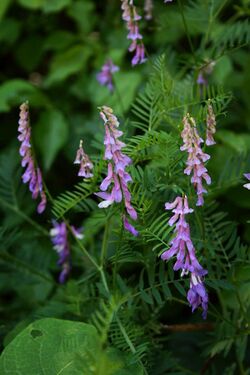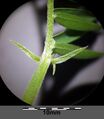Biology:Vicia tenuifolia
| Vicia tenuifolia | |
|---|---|

| |
| Scientific classification | |
| Kingdom: | Plantae |
| Clade: | Tracheophytes |
| Clade: | Angiosperms |
| Clade: | Eudicots |
| Clade: | Rosids |
| Order: | Fabales |
| Family: | Fabaceae |
| Subfamily: | Faboideae |
| Genus: | Vicia |
| Species: | V. tenuifolia
|
| Binomial name | |
| Vicia tenuifolia Roth, 1788[2]
| |
| Synonyms[2] | |
|
List
| |
Vicia tenuifolia, the fine-leaved vetch, cow vetch,[3] fodder vetch[4] or bramble vetch,[1] is a herbaceous perennial plant species in the family Fabaceae.[5] This species is widespread in Europe and some parts of both Asia and Africa. In some other areas it occurs as an introduced species.[1] In a few countries this edible vetch is used as food for both humans and farm animals.[5]
Taxonomy
Vicia tenuifolia was described by German botanist Albrecht Wilhelm Roth in his work Tentamen florae germanicae in 1788.[2] Some taxonomists treat this species as a subspecies of Vicia cracca, while most recognize it as its own species.[2][6]
There are a few recognized subspecies:[2]
- Vicia tenuifolia subsp. atroviolacea (Bornm.) Greuter & Burdet
- Vicia tenuifolia subsp. delmasii (Emb. & Maire) Dobignard
- Vicia tenuifolia subsp. subalpina (Grossh.) Zernov
- Vicia tenuifolia subsp. tenuifolia
- Vicia tenuifolia subsp. variabilis (Freyn & Sint.) Dinsm.
- Vicia tenuifolia subsp. villosa (Batt.) Greuter
Description
This herbaceous and perennial legume can reach from 30 to 150 centimetres of height. It is usually an upright-growing and spread out vetch with rough stem that is either hairless either hirsute.[5] As with many other pea family species, Vicia tenuifolia is a nitrogen-fixing plant.[3]
Its alternately arranged leaves are pinnately compound and most of the times consist of 10–18 pairs of narrowly linear to oblong leaflets.[5][7] Pinna can be both hirsute or hairless and usually measure from 2 to 6 millimetres. Vicia tenuifolia has so called paripinnate leaves, that end with a split tendril. Stipules are present; they are narrowly linear, with entire leaf margin and end with a sharpened point.[5]
The species is an entomophilous plant[3] and flowers between June and August.[8] Vicia tenuifolia has typical bilaterally symmetrical papilionaceous flowers, that consists of a banner, keel and wing, with the flower's petals being red, pink or blueish purple. The biggest petal – the so-called banner – is brighter than other petals, with its limb being as long as its claw.[5] From 15 to 30 small flowers are arranged into an raceme inflorescence,[7] that has long leafstalk (the latter is usually twice as long as the inflorescence). The flower's sepals are fused together into a few millimetres long calyx tube that ends with 5 short calyx tooth. Each flower has 10 anthers; the latter are fused together till the last third of anther's length.[5]
This species' dried fruit is a brownish and hairless legume that can measure from 3 to 5 centimetres.[5]
Vicia grandiflora can be confused with the similar vetch species Vicia dalmatica, Vicia cracca, Vicia incana and Vicia villosa.[5]
Distribution and conservation
This vetch species is widely distributed across Europe (especially the Euro-Mediterranean region,[9] south and central Europe[10]) and occurs also in some parts of Asia (usually those that are either temperate either tropical,[1] mostly southwestern and central Asia[10]), as well as in northern Africa.[1] In north-western Europe it is not a native species.[6] Vicia tenuifolia was once introduced to Hawaii.[1] In some areas it is treated as an invasive species.[11]
Vicia tenuifolia usually grows in a variety of habitats, which can include both natural and urban areas.[5] This vetch is mostly an inhabitant of lowlands,[6] where it can be found in dry meadows and forest edges, as well as on grassy banks, verges or waste ground, especially near railways,[6] where it is a ruderal species.[5] V. tenuifolia rarely occurs in uplands, with its maximum elevation being around 2,900 metres.[1]
This species is listed as least concern (LC) species on the IUCN Red list, with its population being rated as stable.[1]
Gallery
References
- ↑ 1.0 1.1 1.2 1.3 1.4 1.5 1.6 1.7 Lopez Poveda, Lucia (2010-08-03). "IUCN Red List of Threatened Species: Vicia tenuifolia". https://www.iucnredlist.org/en.
- ↑ 2.0 2.1 2.2 2.3 2.4 "Vicia tenuifolia Roth" (in en). https://www.gbif.org/species/2975188.
- ↑ 3.0 3.1 3.2 "Vicia tenuifolia Fine-Leaved Vetch, Cow vetch PFAF Plant Database". https://pfaf.org/user/Plant.aspx?LatinName=Vicia+tenuifolia.
- ↑ "Vicia tenuifolia" (in en-US). 2019-07-21. https://plantsbank.com/vicia-tenuifolia/.
- ↑ 5.00 5.01 5.02 5.03 5.04 5.05 5.06 5.07 5.08 5.09 5.10 "Drobnolistna grašica – Urbanatura" (in sl). https://www.urbanatura.si/vsebina/1252.
- ↑ 6.0 6.1 6.2 6.3 "Vicia tenuifolia | Online Atlas of the British and Irish Flora" (in en). https://plantatlas2020.org/atlas/2cd4p9h.9cy.
- ↑ 7.0 7.1 "Fine-leaved vetch (Vicia tenuifolia) – Plants | Candide Gardening" (in en-GB). https://candidegardening.com/GB/plants/14cf92cc-0e14-40a5-858b-18d3aa740479.
- ↑ "Vicia cracca subsp. tenuifolia". https://www.infoflora.ch/de/flora/vicia-cracca-subsp-tenuifolia.html.
- ↑ "Vicia tenuifolia (VICTF)[Overview| EPPO Global Database"]. https://gd.eppo.int/taxon/VICTF.
- ↑ 10.0 10.1 "Vicia tenuifolia Roth" (in en-us). 2017-10-17. https://www.cwrnl.nl/en/CWRnl-1/CWRbyname/Vicia-tenuifolia-Roth-1.htm.
- ↑ "Vicia tenuifolia". https://www.cabi.org/isc/datasheet/117852.
External links
Wikidata ☰ Q161359 entry
 |










